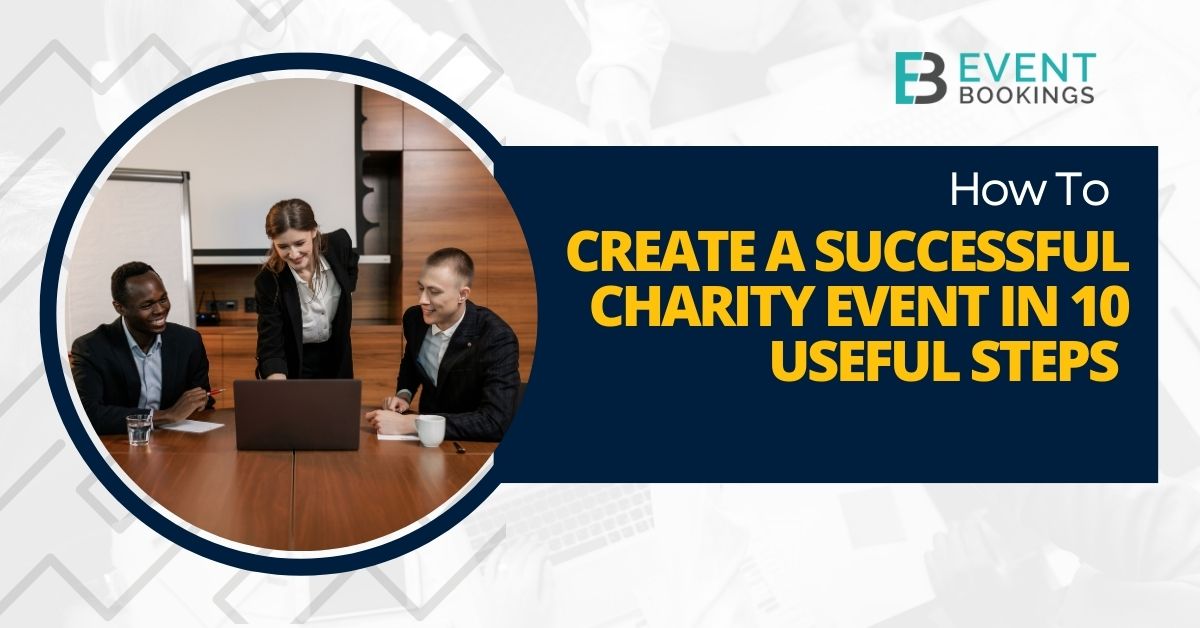Organizing fundraisers is a highly efficient way of collecting funds for a non-profit organization. Though Planning a charity event can feel like a daunting task, with the right approach, it’s an enriching experience that brings people together for a great cause. Whether you’re organizing a small community fundraiser or a large-scale gala, the key to success lies in careful planning and creative thinking.
If you need help with how to do a fundraiser, this article is for you. We’ll walk you through ten practical steps to help you host a memorable and effective charity event. From setting clear goals to engaging your audience, these tips will empower you to plan an event that not only raises funds for those in need but also inspires and unites your community. Let’s look at those ten steps and realize your charitable dreams!
Step 1: Define Your Event Goals
It’s more important to set a goal before asking yourself how to raise money for charity. Setting a fundraising goal in advance will help you know exactly what you want to accomplish with your charity event, even though ambition is a crucial component of working with any organization. Knowing your fundraising goal can help you determine how many events or activities you need to add to your event to raise donations.

Are you focused on raising money, spreading awareness about a cause, or engaging with a particular community? Your event goals will guide every decision you make, from the type of event you host to the promotional strategies you use. Having well-defined goals will also assist you in measuring the success of your event once it’s over.
Step 2: Establish a Budget
Once your goals are set, the next step is to establish a budget. It is a fundamental step in planning your charity event, laying the groundwork for all your financial decisions. When crafting your budget, consider the following key areas:
- Event Fundraising Software: Investing in the right fundraising software can streamline donations, track contributions, and provide valuable insights into your event’s performance. Allocate funds for a user-friendly platform that meets your event’s specific needs.
- Event Management: Whether you hire an event planner or use event management software, budget for the tools or personnel needed to organize and execute your event smoothly.
- Auction Tools: If you plan to hold an auction, factor in the cost of auction tools, whether physical bidding paddles or digital platforms.
- Online Giving: Many donors prefer the convenience of online giving. Include the costs of securing online donation portals to facilitate easy and quick contributions.
- Text-to-Give: Text-to-give options allow attendees to donate via mobile phones, making it easy for people to contribute. Ensure your budget accounts for any fees associated with implementing this technology.
- Sponsor Management: Budget for tools or services that help with sponsor outreach, agreements, and fulfilment of sponsor benefits.
- Space-Related Costs: Whether you’re renting a venue or using a public space, the location will have costs associated with it. Consider expenses like rental fees, insurance, permits, and any necessary modifications to the space.
- Event Perks: Providing swag bags, VIP access, or special seating can enhance the guest experience. Be sure to include these in your budget.
- Technology: Technology plays a significant role in today’s events, from audiovisual equipment to Wi-Fi services. Budget for the necessary tech tools to support presentations, live streams, and other digital needs.
- Promotional Items: Finally, remember the cost of promotional items. Whether event-branded merchandise, flyers, or social media ads, these items are crucial for spreading the word and attracting attendees.
If you are interested, you can take a quick look at How to Prepare a Killer Event Budget
Step 3: Assemble a Planning Team
A successful charity event relies on the efforts of a dedicated and skilled planning team. To get started, gather a group of individuals dedicated to the cause and possess various skills. Diversity in expertise is key—consider including people with backgrounds in event planning, marketing, fundraising, logistics, and finance.

Assign targeted responsibilities to each team member based on their strengths. For example, you might have someone overseeing sponsorships, another handling volunteer coordination, and someone else focused on marketing and promotions. Clear communication and regular meetings are essential to keep everyone on the same page and ensure that all aspects of the event are progressing smoothly.
Step 4: Choose a Suitable Venue
The venue decides the tone for the entire experience and plays a significant role in the event’s overall success. Start by considering your event’s goals, the number of attendees, and the type of atmosphere you want to create. Whether you’re hosting a formal gala, a casual outdoor gathering, or a virtual event, the venue should match your vision and accommodate your needs.

When evaluating potential venues, consider location, accessibility, parking, and amenities. It’s also essential to consider logistics—does the venue have enough space for your planned activities, such as dining, entertainment, or auctions? Additionally, inquire about on-site services, such as catering, audiovisual equipment, and Wi-Fi, as these can save you time and money.
Finally, consider your budget when choosing a venue. While it may be tempting to choose the most impressive option, balancing cost with practicality is essential.
Step 5: Plan the Event Program
The event program is the backbone of your charity event, guiding the flow of activities and ensuring that everything runs smoothly. Start by outlining the key segments of your event. Think about what needs to happen and when. This might include guest arrivals, opening remarks, speeches, entertainment, auctions, dinner, and any special presentations or acknowledgments.
When planning the program, consider the pace and timing of each segment. You want to keep your audience engaged, so avoid long gaps or drawn-out speeches. Mix up the content to maintain energy. For example, balance formal elements like speeches with lighter moments like performances or interactive activities.
Coordinating with your vendors, speakers, and entertainers is crucial to ensure everyone knows their role and timing. A well-thought-out program should also include flexibility, allowing you to adapt to any unexpected changes or delays on the event day.
Step 6: Promote Your Event
Effective promotion is key to drawing in attendees and maximizing the impact of your charity event. By leveraging a mix of communication channels, you can connect to a broader audience and ensure that your message resonates with potential supporters. Here’s how to do it:
- Social Media: Create engaging and eye-catching content highlighting the cause, sharing event details, and encouraging followers to register or donate. Use a mix of posts, stories, and live videos to build excitement, and don’t forget to create an event hashtag to increase visibility and engagement.
- Your Website: Your website should be the central hub for all event information. Create a dedicated event page that includes the date, time, location, and a compelling description of the cause. Make it easy for visitors to register, donate, or learn more about how they can get involved
- Email: Send out emails leading up to the event, starting with a save-the-date announcement, followed by reminders and last-minute calls to action. Customize your messages to different sections of your audience, such as past donors, potential sponsors, and general supporters, to increase engagement.
- Text Messaging: Use SMS to send out event reminders, exclusive updates, or special incentives like early-bird ticket discounts. Since people tend to check their texts immediately, this method can be particularly effective for last-minute promotions or on-the-day updates.
- Press Releases: Write a compelling press release that highlights the event’s importance, goals, and notable speakers or activities. Distribute it to local news outlets, blogs, and online publications to increase your event’s visibility and attract more attendees.
Read More: How to Write A Press Release for An Event
- Direct Mail (Including Invitations): While digital communication is crucial, consider the power of direct mail. To add a personal touch, send out formal invitations to key supporters, sponsors, and VIPs. You can also use direct mail to distribute flyers or brochures outlining the event’s purpose and benefits. Take it a step further by using a QR code creator to generate QR codes that link directly to event details, registration pages, or donation platforms. This modern touch adds an interactive element to your materials, making it effortless for recipients to engage with your event.
Step 7: Manage Ticket Sales and Registration
Efficiently managing ticket sales and registration is key to ensuring your event runs smoothly and reaches its full potential. Start by selecting an online ticketing platform that’s easy to navigate for you and your attendees and performs well as a fundraising event software. This platform should allow guests to purchase tickets and register in just a few clicks, offering a seamless experience.
Consider offering different ticket options to cater to various audience segments. Early-bird discounts, group rates, or VIP packages can attract a wider range of participants. Ensure your registration page is clear and displays all essential details like event date, time, location, and ticket prices.
Once registrations start coming in, use the platform to track sales, monitor attendance, and manage attendee information. Automated confirmation emails and reminders can help keep your guests informed and reduce no-shows. The more streamlined and user-friendly your ticketing and registration process, the more likely people are to sign up and attend your event.
Step 8: Coordinate Logistics
Logistics are the nuts and bolts that hold your event together, and getting them right is essential for everything to run smoothly. Start by mapping out all the logistical details early on, including securing the venue, arranging transportation, coordinating with vendors, and ensuring you have all the necessary permits.
Think about the flow of the event from start to finish. How will guests arrive? Where will they park? How will you handle check-ins? Walk through the event in your mind (or, even better, do a physical walkthrough) to spot any potential issues before they become problems.
Having a solid plan for setting up and breaking down the event space is also important. Keep communicating with your team to ensure everyone knows their role and what’s expected of them on the event day. This could mean assigning someone to oversee the setup of tables and chairs, managing audiovisual equipment, or coordinating with caterers.
Step 9: Engage Attendees During the Event
Engaging your attendees is all about creating a memorable and meaningful experience. Start with a warm welcome—have friendly volunteers greet guests, help them with check-in, and guide them to where they need to be. A personal touch goes a long way in making people feel valued.
During the event, keep the energy up by mixing things up. Incorporate a variety of elements like live music, interactive activities, or surprise performances. If your event includes speeches or presentations, keep them short, impactful, and aligned with the cause. People are more likely to stay engaged when they feel emotionally connected, so don’t hesitate to share powerful stories or testimonials that highlight the charity’s impact.
Interactive elements can also make a big difference, so try adding them. Consider adding a Q&A session, live polling, or social media challenges where attendees can post photos with a specific hashtag. These activities keep people engaged and help spread the word about your cause beyond the event.
Step 10: Follow Up After the Event
Following up after the event is essential for showing appreciation, sharing the impact, and building lasting connections.
Start by sending personalized thank-you messages to everyone who participated—attendees, donors, volunteers, and sponsors. A simple email or a handwritten note can go a long way in making people feel valued and recognized for their contribution.
Next, share highlights from the event. This could be a recap email with photos, videos, and key moments or a post-event newsletter that includes the total amount raised and how those funds will be used. Social media is another great platform for sharing event successes and giving shout-outs to everyone who helped make it happen.
This is also the perfect time to ask for feedback. Send out a quick survey to attendees to gather their thoughts on what they enjoyed and what could be improved. Their feedback can help you provide valuable insights for future events and show that you care about their experience.
The first step is defining your fundraising goals before organizing a school fundraiser. Determine what you’re raising money for, how much you need to increase, and how you plan to achieve that. This will guide the type of event you choose and help you create a plan to meet your objectives.
Standing committees typically handle recurring tasks in an organization. These groups focus on ongoing activities such as finance, marketing, event planning, or membership management, ensuring the organization’s smooth operation.
When selecting an event venue, you should consider:
✅ Location: Ensure the venue is accessible to your target audience, with convenient transportation and parking options.
✅ Capacity: The venue should comfortably accommodate your expected number of attendees.
✅ Amenities: Check for on-site services like catering, audio-visual equipment, and Wi-Fi to meet your event’s needs.
When you first start planning a special event, the most important thing to figure out is its purpose and goals. Understanding the “why” behind the event will guide decisions about the type, audience, venue, and budget, ensuring all efforts align with your objectives.
Last Words
In conclusion, planning a successful charity event takes time, effort, and attention to detail, but its impact on your cause makes it all worthwhile. By following these ten steps, you won’t have to worry about raising money for charity, and you’ll be well on your way to creating an event that meets your goals and also leaves a lasting impression. Remember, the key is to stay organized, engage your audience, and keep your cause at the heart of everything you do.




